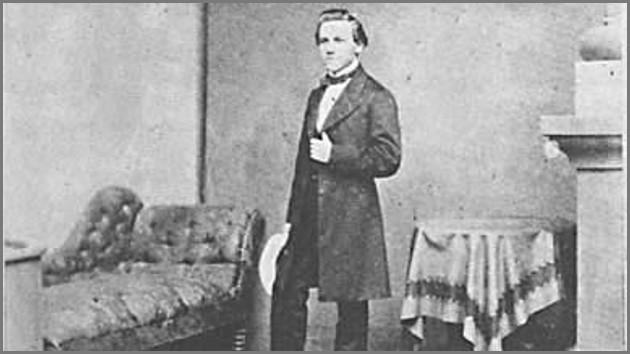
Visions of Morphy
Below are some of the images - photos, paintings, sketches, etchings - of Paul Morphy.
Here is the earliest known image of Morphy - from 1854:
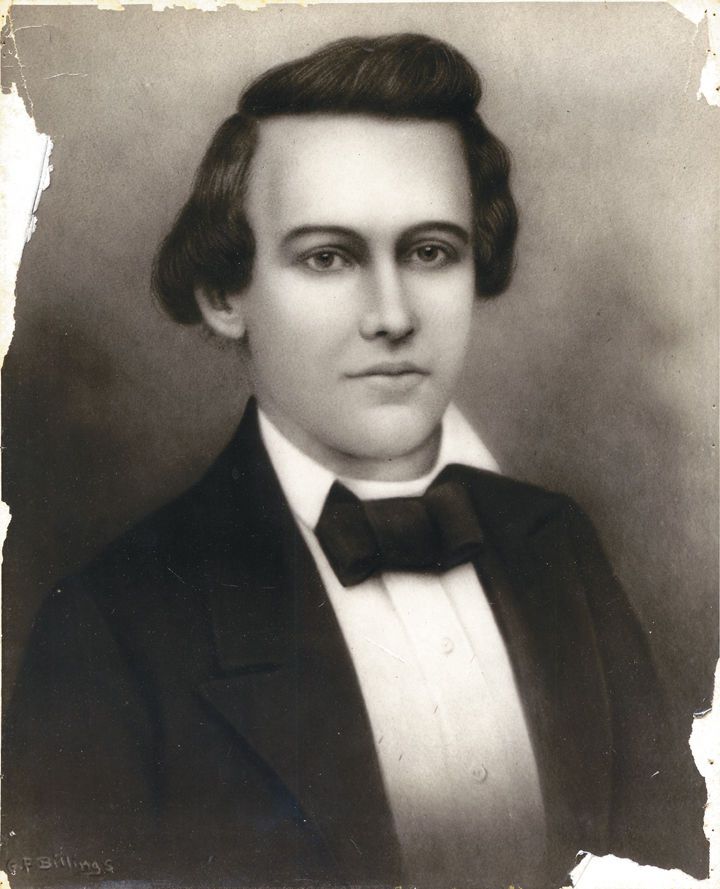
from "Twice Remembered: Moments in the History of Spring Hill College" by Michael Kenny, S.J.


Several non-photographic renditions, such as the two above, appear to have been created from the initial 1854 photograph.
Enter: Mathew Brady
In 1844, at the young age of 22, Mathew Brady opened his studio in N.Y.C. His studio became the focal point for the photographic arts and produced images of many famous persons. He or his assistants made several photographs of Paul Morphy and the players from the 1st American Chess Congress in 1857.


The following lithograh was made from a Mathew Brady Photograph:

This same image was used on the silver salver fabricated, which along with a pitcher and four goblets, was created by Ball, Black & Co. of N.Y.C. and presented to Morphy for winning the 1857 Chess Congress:

The inscription reads:
This Service of Plate
is presented to
PAUL MORPHY
The Victor in the Grand Tournament
at the First Congress
of the
American National Chess Association
New York, 1857
is presented to
PAUL MORPHY
The Victor in the Grand Tournament
at the First Congress
of the
American National Chess Association
New York, 1857
This lithograph of the Congress players was made from a photo by Brady:

Standing (l-r): Perrin, Lichtenhein, Colthrop, Stanley, Thompson, Raphael, Fiske, Mead, Hammond, Marache, Knott Frère.
Sitting (l-r): Allison, Paulsen, Meek, Morphy, Kennicott.
Sitting (l-r): Allison, Paulsen, Meek, Morphy, Kennicott.

Paul Morphy, the Chess Champion
This wood engraving by marine/landscape artist, Winslow Homer, first appeared in "Ballou’s Pictorial Drawing Room Companion" July 2, 1859.

This oil painting by Charles Loring Elliott, June 1859, hung on the wall of the Manhattan Chess Club for over a century.
Thomas Frère, in the Martinello's Rooms at 110 5th Ave., N.Y. on the evening of March 1st, 1884 spoke:
"The agreeable duty has been assigned to me of presenting to the Club, on the part of the Directory, his fine portrait, by Elliott, of the Master Player, Paul Morphy."
. . .
"You have him here, gentlemen, as portrayed by Elliott, 'The finest Chess player, by the finest American portrait painter.' It is a work worthy of your admiration and of you most vigilant preservation."
"At a special meeting of the Manhattan Chess Club held at their rooms, 104, East 14th Street, July 15, 1884, city of New-York, the following preamble and resolutions were unanimously adopted:
"WHEREAS, the Manhattan Chess Club have learned with deepest regret of the death of Paul Morphy, and desire to express their sorrow at the loss of one who by his matchless skill in their noble game, earned for himself the FIRST PLACE in the roll of CHESS MASTERS, and by his true modesty and worth gained the esteem and respect of all who knew him,
"RESOLVED, that the portrait of PAUL MORPHY in the rooms of the club, be draped in mourning for a period of three months."
"The agreeable duty has been assigned to me of presenting to the Club, on the part of the Directory, his fine portrait, by Elliott, of the Master Player, Paul Morphy."
. . .
"You have him here, gentlemen, as portrayed by Elliott, 'The finest Chess player, by the finest American portrait painter.' It is a work worthy of your admiration and of you most vigilant preservation."
"At a special meeting of the Manhattan Chess Club held at their rooms, 104, East 14th Street, July 15, 1884, city of New-York, the following preamble and resolutions were unanimously adopted:
"WHEREAS, the Manhattan Chess Club have learned with deepest regret of the death of Paul Morphy, and desire to express their sorrow at the loss of one who by his matchless skill in their noble game, earned for himself the FIRST PLACE in the roll of CHESS MASTERS, and by his true modesty and worth gained the esteem and respect of all who knew him,
"RESOLVED, that the portrait of PAUL MORPHY in the rooms of the club, be draped in mourning for a period of three months."

The above image, based upon Charles Loring Elliot's oil painting appeared in March 1888 issue of "Harper's New Monthly Magazine" as part of an article called, "Chess in America" by Henry Sedley. Sedley, born in England but living in the United States, died just a decade later (Jan. 8, 1898) after a protracted five year illness. As a chess player, Sedley was considered a first-class amateur. He presided over the dinner for the 6th American Chess Congress. But he was also a published novelist and a journalist who had edited the "Round Table" as well as having worked with William Cullen Bryant and Parke Godwin on the "Evening Post."

from a photograph by John Thompson (1837-1921)

Jules Émile Saintin (1829-1894)
Jules-Êmile Saintin's miniature painting of Morphy was first displayed at the 35th Annual Exhibition of the National Academy of Design in 1860.

Like Paul's father, Solomon Nunes Carvalho (1815-1894) was born in Charleston, South Carolina. He was both a painter and a photographer. When Morphy visited the Monumental Chess Club, Carvalho offered to paint his portrait which is now belongs to the Maryland Historical Society.
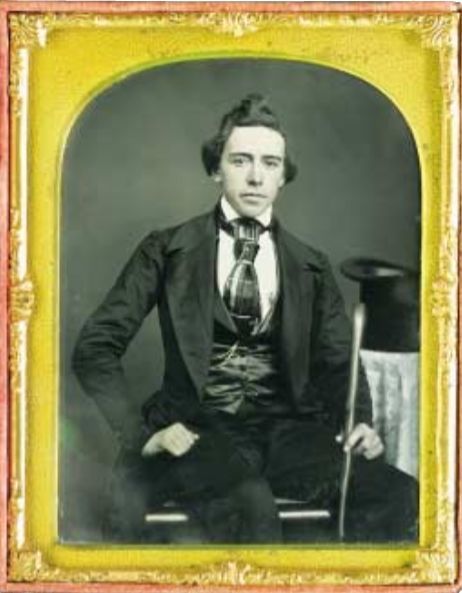
Morphy sporting his cane and top hat in this daguerreotype from ca. 1857-9

Morphy on his arrival in London 1859
"He was, literally speaking, canopied with a huge, broad Panama hat, and wore a light suit of clothes, seemingly of fine gray linen ; he was neat in his dress and gentlemanly in demeanor. " —Rev. G. A. MacDonnell, "Chess Life-Pictures"

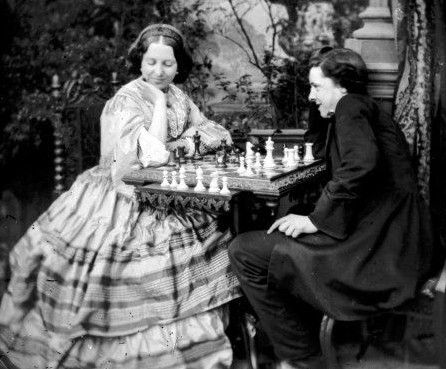

Anderssen and Morphy by Otto Spamer of Liepzig
Max Lange and Otto Spamer were publishing business partners. Spamer was also Lange's father-in-law.

This image, taken in the studio of Frederick Gutekunst of Philadelphia, appeared in "Chess in Philadelphia," by Gustavus Reichhelm in 1898. The American Chess Magazine had written, upon the impending publication of Reichhelm's book, "Paul Morphy and Lewis Elkin at the chess board will be new to the chess world. It will form the initial illustration of the new book, "Chess in Philadelphia," noticed In our last issue. It was taken by a lending photographer in 1859 and is a capital likeness of Mr. Morphy at that time."
There is a Lewis Elkin Elementary School in Philadelphia named for him. The original building was completed in 1904 but burned in 1929. The current building was constructed in 1973.
Lewis Elkin was a Director of the Pennsylvania Railroad (his office at 1119 Walnut. St.) and held other positions with various railroads. He married a former school teacher, Matilda Patton, in 1883. After having taught for only 2 years, Matilda was made principal and head teacher of the Free Night School for young women in its inaugural year. The following year she was appointed Chief Librarian of the Free Library Institute of Philadelphia. Because of his wife, when Lewis Elkin died on July 7, 1901, he left a large portion of his considerable estate tha a fund he named, "The Lewis Elkin Fund for the Relief of Disabled Female School Teachers in the employ of the City of Philadelphia." When Mrs. Elkin died in 1907, she too gave a large portion of her estate to the fund and $1000 to the Free Library.

also from "Chess in Philadelphia" - Morphy in the Fall of 1859
There is a Lewis Elkin Elementary School in Philadelphia named for him. The original building was completed in 1904 but burned in 1929. The current building was constructed in 1973.
Lewis Elkin was a Director of the Pennsylvania Railroad (his office at 1119 Walnut. St.) and held other positions with various railroads. He married a former school teacher, Matilda Patton, in 1883. After having taught for only 2 years, Matilda was made principal and head teacher of the Free Night School for young women in its inaugural year. The following year she was appointed Chief Librarian of the Free Library Institute of Philadelphia. Because of his wife, when Lewis Elkin died on July 7, 1901, he left a large portion of his considerable estate tha a fund he named, "The Lewis Elkin Fund for the Relief of Disabled Female School Teachers in the employ of the City of Philadelphia." When Mrs. Elkin died in 1907, she too gave a large portion of her estate to the fund and $1000 to the Free Library.
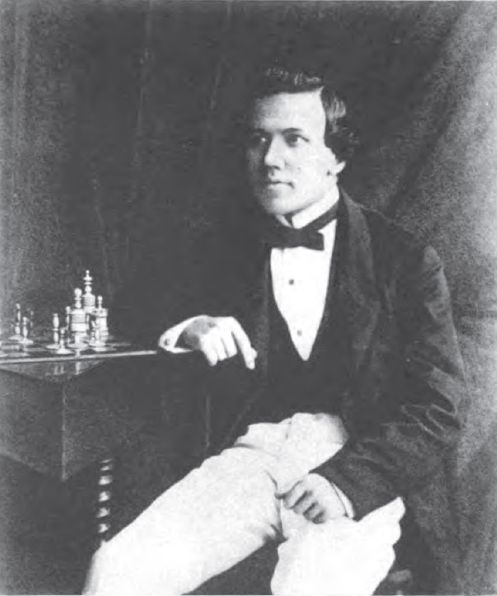
also from "Chess in Philadelphia" - Morphy in the Fall of 1859

Paris 1863

Paris 1867

New Orleans 1870

at the home of Francisco Fésser (Havana), Oct. 17, 1962
A couple of somber images:


Oil painting by A. Rosenbaum, 1880


"Among the first to recognize Morphy’s significance in the chess arena was Eugene Lequesne, the well-known sculptor. Morphy had been in France less than two weeks when Lequesne asked him to sit for his bust in marble. Morphy obliged with the first sitting on September 15. The bust was exhibited as the Exposition des Beaux Arts in 1859. Maurian mentions in the New Orleans Sunday Delta of February 6, 1859, that small replicas (three-fifths the actual size) had arrived in New Orleans by January 1859, and described the bust as “a perfect likeness.” It received special attention the day before Morphy left Paris some months later." —Davd Lawson
"In Paris, on April 4, 1859, at a farewell banquet for him, it was St. Amant who placed a laurel wreath upon the marble bust of Morphy by the sculptor Eugene Lequesne." —Lawson






